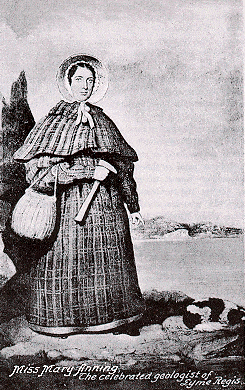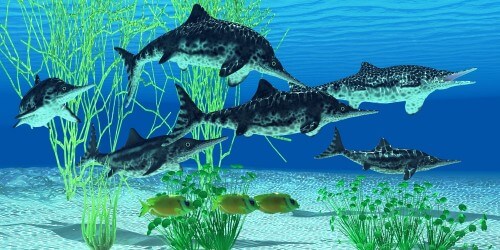How did a poor and uneducated young woman from the south of England at the beginning of the 19th century become the most important finder of fossils, and why was she forgotten - hint, Agalia at that time was a man's world

Despite the fact that Marie Anning's life has been the subject of several books and articles, very little is known about her life, and many people are unaware of her great contribution to the field of paleontology in the early days of this science. How can anyone describe the greatest fossil expert in the world, without being aware of the magnitude of his contribution to the science of paleontology? The reason for this is simple: she was a woman in a man's England.
Marie Anning was born to Richard and Marie Anning in Lyme Regis, a coastal town in southern Britain. The cliffs at Lyme Regis are rich in Jurassic marine fossils. Richard and Marie had ten children, but only two of them – Marie and Joseph – reached adulthood. Marie's father, Richard, was a chest maker who occasionally collected fossils. Unfortunately, Richard died in 1810, leaving his family in debt and without a breadwinner. However, he bequeathed his fossil-hunting talent to his wife and children, who subsequently prospered in the burgeoning field of paleontology.
The Anning family lived in poverty and anonymity, initially selling fossils from the Lyme Regis area, until the early 19s, when a professional fossil collector, Lt. Col. Thomas Birch met the family and sympathized with their dire financial situation. Birch decided to hold an auction, sell his entire precious fossil collection and donate the money to the Anning family. He felt that the Anning family should not live in hardship considering the fact that they had discovered almost all the important fossils that became the subject of scientific investigation. Up until this point, Marie Hamm ran the business of collecting fossils. By the mid-twenties, daughter Marie had proven to be sharp-eyed and the family's anatomist and began to take charge of the family's fossil business. Joseph was at that time committed to his career in the upholstery business and no longer collected fossils.
Marie Anning is credited with the first discovery of ichthyosaur fossils (large marine dinosaurs). Although not historically accurate, Marie did assist in the discovery of the first ichthyosaur fossil detail to be officially recognized by the London scientific community. The individual was discovered sometime between 1809-1811, when Marie was 10-12 years old. Marie did discover most of the remains, and it was her brother who discovered part of the dinosaur's chest about a year earlier. Virtually the entire Anning family was involved in the search for fossils, but Marie's skills and diligence produced important discoveries and thus provided the fatherless family with a means of subsistence. The fossils Marie and her family discovered were in demand not only from museums and scientists but also from European nobles, many of whom had private collections of fossils and other interesting things.
Marie made other important discoveries, including well-preserved ichthyosaur skeletons, but perhaps her most important find from a scientific point of view was the discovery of – Plesiosaurs There were ancient reptiles that existed from the Jurassic period to the Cretaceous. They lived in the sea and some of them were gigantic in size.
More on women in science on the science website:
- Maria Gaetana Agnesi - studied mathematics as a hobby and wrote the first textbook in Khado'a
- Sophie Germain - the mathematician who refused to accept a pure gold statue as a prize
- Dorothy Croft Hodgkin, pioneer of X-ray crystallography
- Did Einstein's first wife secretly compose the theory of relativity with him in 1905?

The famous French anatomist Georges Covey questioned the reliability of the fossil when he first examined the detailed illustrations. After Cubier realized that this was a real find, Anning became a legitimate and respected fossil expert in the eyes of the scientific community.
Despite this recognition, most of Marie Anning's fossils have found their place in museums and personal collections without her being given credit for discoveries. As time passed, Marie Anning and her family members were forgotten by the scientific community and by most historians due to the lack of adequate documentation of her special skills. The main reason for this is her economic status and gender. Many scientists at the time could not believe that a young woman from such a low socio-economic background could have the knowledge and skills she presented. For example, this is what Lady Harriet Seabster, the widow of the city recorder of London, wrote in her diary in 1824 after visiting Marie Anning:
"The amazing thing about this young woman is that she made herself so identified with science that as soon as she found a bone she knew what tribe the bone belonged to. She fixed the bones to a frame with plaster and then painted and carved them. This is an excellent example of what she called divine fragrance - a poor and ignorant girl can be gifted and through self-study she reached a level of knowledge that allowed her to correspond and talk with professors and other wise men on the subject, and everyone estimated that she understood this scientific field more than anyone else in the kingdom."
Liddy Sibster used high language, but commented that the "divine fragrance" was responsible for explaining how such a woman could be so knowledgeable. It is therefore clear that Shanning was not only a collector, but also showed orientation, understanding and in-depth scientific knowledge of the items she collected. Her findings were important for reconstructing Earth's past and the history of life.

5 תגובות
Please note, an ichthyosaur is not a marine dinosaur but rather a marine reptile. The dinosaurs lived only on land.
orthodox
Your place is in KKK Kiryat Shaul, Israel
Shabbat Shalom Haredi 🙂
Women should be in the kitchen!!!
What about her and the dinosaurs that did not even exist according to our holy Torah!!!